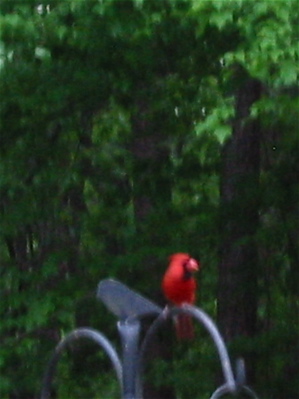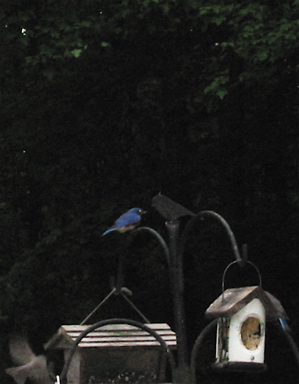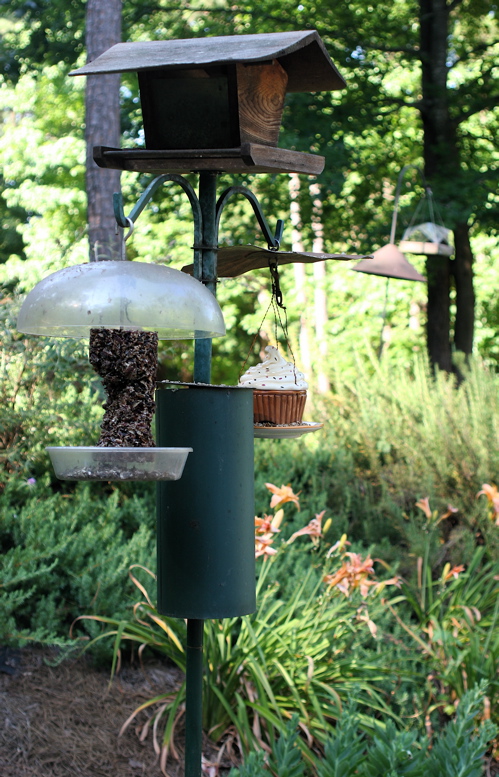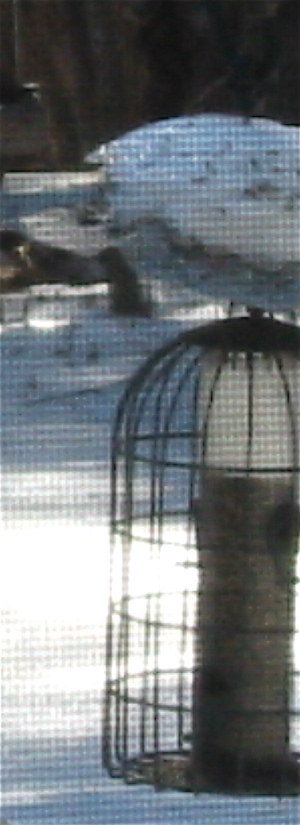-
a great perching spot on bird feeder pole
Because I lack any really decent photography equipment, the image isn’t so great, in fact I was pretending to digiscope with a pair of cheap binoculars. But that’s not the point of this blog. The bird feeder pole where this cardinal is perched sees a whole lot of activity in our back yard. From bluebirds and chickadees to titmice and woodpeckers, the four-arm bird feeder pole offers the perfect perching spot to rest and hunt.
Recently we had a semi-successful brood of bluebirds. Five babies made it out into the world, but the task of raising all five alone must have been too much for mom. Three days before these babies fledged, dad went missing. Perhaps the red-tailed hawk who hangs around, or my neighbor’s pain in the $#@ cats had gotten to him? Although I’ll never know his fate, he did leave his legacy in the three thriving juveniles. They like landing on this bird feeder pole because the mealworm dish is attached to it. They have options where to land and perch, and because the pole’s arms are at two levels, the babies can ease their way down to the dish. New males are in the area, but they’re not so kind to the babies, Mother Nature sure can be brutal at times 🙁
So here’s another pretty bad photo of dad bluebird before he disappeared, perched on the same bird feeder pole
. It’s really stinks not having a decent camera because the birds in our yard are many and varied. There’s an Eastern Phoebe feeding two babies, three kinds of woodpeckers, all the usual suspects, and a thrasher who hangs around. Now, if the darn starlings would just hit the road… all would be well.
-
ok, is it the bird feeder pole or the ground?
It doesn’t look so bad here, maybe the rivets on the baffle are starting to give, and the nice green luster is gone, but this bird feeder pole serves the purpose quite well. Holding a good-size hopper on top, and two hanging feeders, with enough room for weather guards too. It’s really a nice set up. The bottom of the pole even sits in an auger, that screws down into the ground about eight to ten inches. So what’s the problem?
If you could see this bird feeder pole now, you’d laugh, or maybe think “what the heck?”. It now sports a heavy rope which is braced against three ground stakes… professionally tied and knotted by a former sailor! Now I was very excited to purchase a brand new shiny bird feeder pole, which I plan to install as soon as the weather warms up (along with thorough cleanings of all the feeders). I can only hope the triple-braced contraption holds up until then. Today I tightened the rope, and added a small bungee to keep it from slipping further down the pole.
The ground is just overly saturated with water right now 🙁
Besides all the Georgia rain, and snow we’ve had this winter, our leaf misters ran all summer at the top of the small bank. The ground was already wet before winter’s mess. So I’m thinking why did I buy the new pole? Maybe some cement would have been a wiser option.
- Ant Moats, Bird Book, Bird Feeder Pole, Bird Field Guides, Bird Nesting Materials, Bird Seed Trays, Birding Accessories, Misters and Birdbath Drippers, Nesting Material, Squirrel Baffle, Water Wiggler, Weather Guards
squirrel baffle serves as weatherguard too
The most effective way to foil squirrels and protect your feeders from their disruptive antics, is with a squirrel baffle. A quality baffle is a one-time investment that will save your birdseed and ultimately your money in the long run.
The best part about using a hanging squirrel baffle is the versatility. Some folks even use them as weather guards alone (like me) to protect feeders from the elements. Most will serve as weather guards throughout the changing seasons. Keeping snow in winter, rain, and direct sun in sweltering summer heat, from ever reaching and spoiling the bird food. This will also save money by keeping food fresher longer. Not to mention, squirrel baffles also protec
t feathered friends at your feeder while dining. Although this feeder hangs from a pole with a baffle in place, one is also used to protect the feeder. Check out that snow sitting on top!
Planning and proper placement are two key factors when setting up new baffles. One must always remember squirrels’ uncanny acrobatic and athletic abilities! The little furry critters can jump sideways almost 10 feet. So, the horizontal “launching point” must be taken into consideration. Don’t hang the feeder near anything they might be able to jump from sideways. Vertically speaking, be sure the bottom of the feeder is at least five feet from ground level.
All in all, a great investment for novice to advanced backyard birders. Sparing you much aggravation and headache should squirrels be a problem in the yard.





